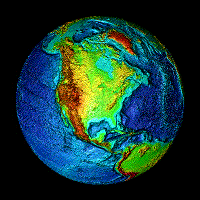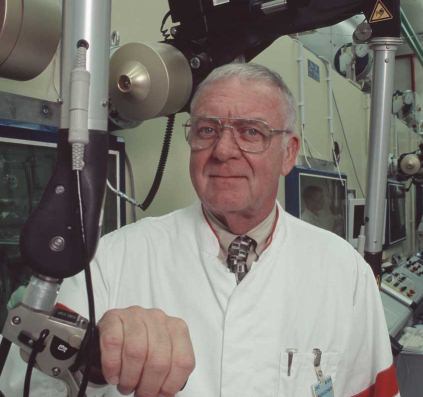 
Quick Overview of J. Marvin Herndon's New Geoscience Paradigm |
 Think
about rain; raindrops falling and falling to Earth. Now, think of a slightly
different rain that began before the Earth formed. Think about a great ball of
gas made of the same mix of elements that formed the Sun. Now, this is a really
large ball of gas, 300 or more times the mass of Earth, and, near the center,
it's hot, maybe 2500 degrees C. (~4500 degrees F.), and the pressures are high, 100 to 1000 times
our atmospheric pressure, and it's cooling. So, at some point it starts to rain
- not water rain - but molten iron rain, that contains other elements that
dissolve in it under these conditions. These dissolved elements include nickel,
sulfur, uranium, some silicon, some magnesium, and some calcium. The iron rain
falls and falls to the gravitational center and forms the Earth's core.
Think
about rain; raindrops falling and falling to Earth. Now, think of a slightly
different rain that began before the Earth formed. Think about a great ball of
gas made of the same mix of elements that formed the Sun. Now, this is a really
large ball of gas, 300 or more times the mass of Earth, and, near the center,
it's hot, maybe 2500 degrees C. (~4500 degrees F.), and the pressures are high, 100 to 1000 times
our atmospheric pressure, and it's cooling. So, at some point it starts to rain
- not water rain - but molten iron rain, that contains other elements that
dissolve in it under these conditions. These dissolved elements include nickel,
sulfur, uranium, some silicon, some magnesium, and some calcium. The iron rain
falls and falls to the gravitational center and forms the Earth's core.
Now, after the core has formed and starts to cool, some of the dissolved elements begin to come out of solution. First to come out are calcium, magnesium, and uranium by combining with sulfur. The calcium and magnesium sulfides float to the top of the core, the uranium sulfide sinks to the center of the Earth where it eventually forms the georeactor, which starts as just a big mass of uranium, about 24 km in diameter. The georeactor powers and produces the Earth's magnetic field and as well as provides a source of heat to power hot-spots, such as underlie Hawaii and Iceland. As the core cools, silicon combines with nickel, and sinks to form the inner core atop the georeactor.
Meanwhile, it's still raining. Now, the rock-forming elements rain down forming the rest of the Earth. Finally, the ices and gases are attracted by gravity and form a planet about the size of Jupiter. Then, as the Sun starts to burn, it goes through a brief unstable period, called the T-Tauri phase, with super-intense solar winds, that strip away Earth's massive gas envelope, leaving behind the rocky Earth that has been compressed to about 64% of its present diameter by the weight of 300 Earth-masses of gas and ice. Inside Earth, great pressures build, and at some point, the solid rock crust begins to crack and Earth begins to decompress, driven by the stored energy of compression remaining from its gas-giant stage. At the surface two kinds of cracks form, one kind has sources of heat that can cause lava to erupt, the other does not, but those cracks provide a place for the lava to fill in. Example: Basalt erupting at mid-ocean ridges (hot crack), traversing the ocean expanse and falling into trenches (cold crack), explains observations attributed to plate tectonics, without requiring mantle convection, plus it explains more, such as how how mountain chains formed from adjustments in surface curvature and how submarine canyons got their start. This is J. Marvin Herndon's new indivisible geoscience paradigm, Whole-Earth Decompression Dynamics.
What was Earth like at this point? The core had already formed; in fact, the core was the first part of Earth to form. The crust and perhaps into the upper mantle was initially quite cold having formed just before the Sun ignited and began stripping away 300 Earth-masses of primordial gases by the super-intense solar wind, which may have cooled the crust even more. There must have been intense bombardment by meteorites and comets in the final stages of Earth formation and after primordial gases were removed; these emplaced iron and iron-loving elements, like nickel, in the upper mantle and in the crust. After the gases had blown away and the violent T-Tauri phase had ended, water began to collect that was brought to Earth’s surface by comets, perhaps the small comets described by Louis A. Frank in the scientific literature and in The Big Splash that he asserts continue today to bring water to Earth. Volcanic eruptions may have contributed water as well. In the absence of ocean basins, inland seas eventually covered much of the Earth’s surface. Oceanic features, such as pillow basalts from underwater volcanic eruptions and banded ironstone deposits, may be found within continent confines.
Meanwhile, deep within the Earth, pressures were building. Occasionally there
would be a “blow out”. Pressure would force a column of matter, from within the
mantle at a depth of about 100 km or more, that would puncture a narrow hole a
few meters in diameter through all of the overlying rock and explode at the
surface in a funnel shape as wide as 200 meters. These are the diamond-bearing
kimberlite pipes. Sporadic, energetic events such as this, though, were just the
serenely whispered overture to the global catastrophic violence that would occur
again and again, splitting the continual crust, creating a new ocean basin, and
wreaking havoc and causing widespread extinction of the species that had
developed on this watery planet.
 For more details, references, and links to download scientific papers
about J. Marvin Herndon's discoveries and insights please see the following
WebPages:
For more details, references, and links to download scientific papers
about J. Marvin Herndon's discoveries and insights please see the following
WebPages:
Early Earth Formation as a Jupiter-like Gas Giant (click here)
Whole-Earth Decompression Dynamics (click here)
Nuclear Georeactor (click here)
Origin of the Geomagnetic Field (click here)
Composition of Earth's Inner Core (click here)
Composition of Earth's Interior Parts below 660 km (click here)
Return to Home Page NuclearPlanet.com